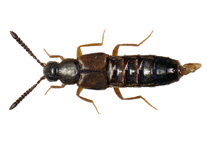Abstract
We describe a new species of dasyurid marsupial within the genus Antechinus that was previously known as a northern outlier of Dusky Antechinus (A. swainsonii). The Black-tailed Antechinus, Antechinus arktos sp. nov., is known only from areas of high altitude and high rainfall on the Tweed Volcano caldera of far south-east Queensland and north-east New South Wales, Australia. Antechinus arktos formerly sheltered under the taxonomic umbrella of A. swainsonii mimetes, the widespread mainland form of Dusky Antechinus. With the benefit of genetic hindsight, some striking morphological differences are herein resolved: A. s. mimetes is more uniformly deep brown-black to grizzled grey-brown from head to rump, with brownish (clove brown—raw umber) hair on the upper surface of the hindfoot and tail, whereas A. arktos is more vibrantly coloured, with a marked change from greyish-brown head to orange-brown rump, fuscous black on the upper surface of the hindfoot and dense, short fur on the evenly black tail. Further, A. arktos has marked orange-brown fur on the upper and lower eyelid, cheek and in front of the ear and very long guard hairs all over the body; these characters are more subtle in A. s. mimetes. There are striking genetic differences between the two species: at mtDNA, A. s. mimetes from north-east New South Wales is 10% divergent to A. arktos from its type locality at Springbrook NP, Queensland. In contrast, the Ebor A. s. mimetes clades closely with conspecifics from ACT and Victoria. A. arktos skulls are strikingly different to all subspecies of A. swainsonii. A. arktos are markedly larger than A. s. mimetes and A. s. swainsonii (Tasmania) for a range of craniodental measures. Antechinus arktos were historically found at a few proximate mountainous sites in south-east Queensland, and have only recently been recorded from or near the type locality. Even there, the species is likely in low abundance. The Black-tailed Antechinus has plausibly been detrimentally affected by climate change in recent decades, and will be at further risk with increasing warming trends.

